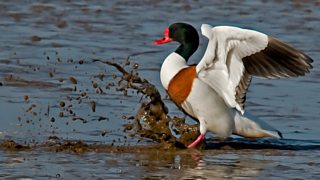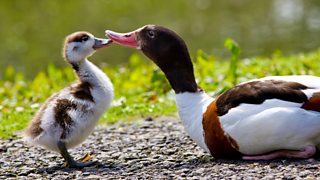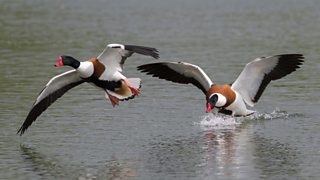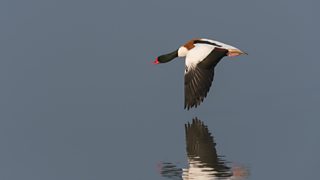This is a good question, because common shelduck are much bigger than mallards and shovelers and spend much more time on land, but are generally smaller than a greylag goose and with a more duck-like head. If you’d guessed that this means it’s more closely related to ducks than geese, you’d be right. But often it’s put in a class of its own, and has its own scientific classification - Tadorna. Far from being related to shells, the prefix ‘shel’ actually relates to the old English word ‘sheld’ meaning ‘pied’ or mixed in colour.

Shelduck family life
If you’re lucky enough to see two common sheducks together in autumn and winter, you might notice them performing various bonding behaviours to one another - one memorable aspect being the female’s curious, deep bubbling call that sounds like eerie laughter. The male communicates with a series of whistles, which (if during the pair bonding process) is accompanied by a cyclical head movement, which the female shelduck seems to find enticing and responds with neck dips and circling swimming motions.

How to tell the difference between a male and female shelduck
At first glance, you might think that male and female shelducks look pretty much alike, They’ve both got a lovely dark-green head and neck, as well as a chestnut band across their chest. They’ve got pink legs and feet, too. There are a couple of main differences, though.
First, the male is a little bigger than the female, so if they’re standing next to each other, you can easily tell which one’s which.
But what if you can only see one shelduck by itself? Here’s a clue: take a closer look at the head. On the female, there’s a little bit of white just above the bill. But the main difference is that lumpy knob at the top of the male’s bill.
Shelduck broods are big, with anywhere between eight and 15 youngsters in a single family. Not surprisingly, keeping them all together can be challenging. So instead, shelduck often coalesce their broods into one mega-nursery of shelducklings within the first week after hatching. This is different to the approach of the less social mallards, who work assiduously to make sure their brood of ducklings is definitely theirs. The shelduck have a more free for all approach, with the advantage that all adults in the area can work together to protect this large brood from predators. If an adult shelduck is on the water with the creche and senses danger, all the ducklings will dive down to escape, whilst the adults take off in different directions to lure the potential danger away.

Managing wetlands for waterbirds like the shelduck
Creching is just one of the unusual things about shelduck. There’s something really rather elegant about shelduck ducklings, but their start in life is often far from elegant, as shelduck favour scruffy low nests such as rabbits’ burrows and tree holes. They’ve even been known to nest in pruned or ‘pollarded’ willow trees, as reported by Dave Paynter, Reserve Manager at WWT Slimbridge. Even more oddly, they continue their sociable behaviour by often scouting for suitable nest sites in small groups, very different from other waterbirds who can be extremely territorial to their own small family. Perhaps this is why shelduck seem so frequently to incur the ire of nesting avocets at Slimbridge, inadvertently providing a show as the hapless shelduck is driven away by the enraged wader.
In terms of nesting, all shelducks really need is a safe, concealed corner, so we make sure there are plenty available on our wetlands sites - they’ll use hay barns, holes under rocks, thickets and abandoned buildings. A long way, seemingly, from the habitat of a duck.

Why do shelduck numbers increase in the UK in autumn?
Another curious thing about the shelduck is their late summer to autumn migration pattern for breeding birds. The shelduck doesn’t have a conventional migration. Instead, shelduck make a single long push that starts in midsummer, followed by a saunter back at no great pace, sometimes taking many months to return to their breeding grounds. The point of this movement is very specific - they travel to moult, and return to mate.
In common with many ducks, when they moult the breeding shelduck replace their main wing feathers all at once and become briefly flightless. This is a fraught time, and dangerous for relatively large birds with multiple predators. So rather than taking its chances on the British estuaries, the shelduck flies to the bountiful wilderness of the Waddensee, an area of the North Sea between Germany and Denmark. Here, a quarter of a million shelducks from all over Europe meet together and moult on the mudflats. Long mudflats are shelduck paradise, because they’re rich in the shelduck’s staple food the mud snail, and land predators don’t venture there.
Most birds depart in mid-summer and wing their way leisurely back to the UK for autumn, using a gentle following wind to make the journey in one go. Strangely, this happens when the youngsters are not even fully grown. The adults, demonstrating another example of high-level social interactions, leave their progeny in the care of a few selected adults who stay behind. After a few weeks, the young become fully independent and make the journey on their own. Why the adults don’t wait, and how this process is communicated, is still a bit of a mystery.
Another strange thing is that some shelduck have started opting for much closer moulting centres with similar habitat to the Waddensee, like WWT Steart Marshes or Bridgewater Bay in Somerset. But the majority still fly the 1,000km east rather than 90km west. Perhaps, unlike barnacle geese (who our studies have shown are already adapting their migration routes to the effects of climate change) shelduck are like most other waterbirds and are a little slow to drop the habits learned through generations, and are not prepared for the shockingly quick changes to our environment that could be around the corner if we don’t act fast.

About WWT
Loss of wetland habitat for waterbirds like sheluck through climate change and other threats such as human development and pollution remains a key issue. WWT are the leading wetlands charity in the UK, working to create, protect and restore wetlands for wildlife and people.
